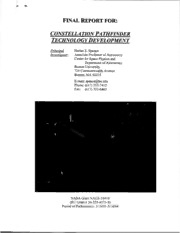
NASA Technical Reports Server (NTRS) 20040084363: Constellation Pathfinder Technology Development PDF
Preview NASA Technical Reports Server (NTRS) 20040084363: Constellation Pathfinder Technology Development
FINAL REPORT FOR: CONSTELLATION PATHFINDER TECHNOLOGY DEVELOPMENT Principal Harlan E. Spence Investigator: Associate Professor ofA stronomy Center for Space Physics and Department of Astronomy Boston University 725 Commonwealth Avenue Boston, MA 02215 E-mail: [email protected] Phone: (617) 353-7412 Fax: (617) 353-6463 NASA Grant NAG5-10419 (BU Grant # 20-325-4573-5) Period of Performance: 3/15 /01 - 3/14/04 Final Report Summarv of Research This final report describes the efforts accomplished during the grant’s period of performance, covering the period of 15 March 2001 to 14 March 2004, of an unsolicited NASA proposal entitled “Constellation Pathfinder Technology Development.” We have completed the goals set forth in the proposed research objectives. An overview of these studies is summarized below. Novel magnetometer boom design and prototype manufacture - For all upcoming nanosatellite space physics missions, a magnetometer will be part of any scientific payload. For the purposes of this prototyping study, we chose a digital magnetometer as the strawman payload of Constellation Pathfinder (CP). In our original CP design, the magnetometer was affixed to a rigid boom in order to place it far enough away from sources of magnetic clutter produced by the spacecraft electronics and solar panels (see Figure 1). As we anticipate launching many of these in a single launch the overall mechanical design is driven by packaging concerns and thermal constraints. Several nanosatellites are envisioned to rest on a single ejection post, hence the need for a hole at the spacecraft’s center of gravity. Encapsulated springs provide the axial thrust needed to sequentially separate the individual spacecraft from a mother ship; these springs also provide the secondary benefits of nutation damping. Thermal control coatings and good thermal design are important considerationsw ith this craft which has a much larger surface-area-to-volumer atio than traditional spacecraft and which must tolerate moderately long eclipses. Figure 1.View of the original CP nanosatellite design, showing the digital magnetometer at the end of a rigid boom, a deployable RF antenna, spring ejection system, battery boxes, electronics box, and cold gas thrusters. In order to maximize packing of the nanosatellites, we explored the feasibility of an extensible boom with this study. The design we chose was based on the concept of nested cups, in this case the cross section being polygonal in order to maintain position knowledge in the azimuthal direction. A mould was constructed of the appropriate length and diameter; the mould had a slight taper. This mould was used to first lay up a G-10 fiberglass boom (see Figure 2, left). After being freed fi-om the mould, the hollow fiberglass boom was sectioned into eight segments and nested (see Figure 2, right). When stowed, the boom was only a few inches long. When deployed, the boom possessed a desired length equal to the diameter of the spacecraft. The spin-up mechanism of the spacecraft would produce the centripetal force needed to deploy the boom. Upon completion of the fiberglass boom, a second boom was constructed using carbon fiber to improve rigidity and strength. Engineering drawings of the stowed and extended booms are included in the lee panels of Figure 3; the boom connected to the nanosatellite structure is shown in the right panel. We conclude that this design may be sufficient for missions requiring only crude magnetometer pointing requirements (such as those at fairly high altitudes) but would not be sufficient for missions requiring stringent directional information, such as those at lower altitudes. Figure m mould (right). -- Figure 3. Boom shown in stowed, extended, and as attached to nanosatellite configuration. 2 Spacecraft structure desim and manufacturability A considerable issue with the deployment of a fleet of nanosatellites is their manufacturability. The traditional cycle time for building must be reduced greatly if we are to field a large number of hand-built units. This applies to both electronics as well as mechanical structure. With this in mind, we also explored the possibility of constructing a carbon fiber structure. A mould was constructed from a hogged out piece of plastic in the hexagonal shape of the nanosatellite body (see Figure 3). As before, a prototype spacecraft shell was made first from G-10, followed by one using carbon fiber. While the strength of this shell was found to be sufficient, and while this process was relatively easy to effect, the final outside surface was poor and required machining. That process was difficult and insufficient. Based on our experience, we conclude that the advantages (including electrical) of using aluminum for spacecraft structure outweigh any advantages that might be gained by using composite materials. Figure 3. Spacecraft body mould. List of Inventions No inventions were developed as a result of this research effort for the entire performance period covered in this report. 3
